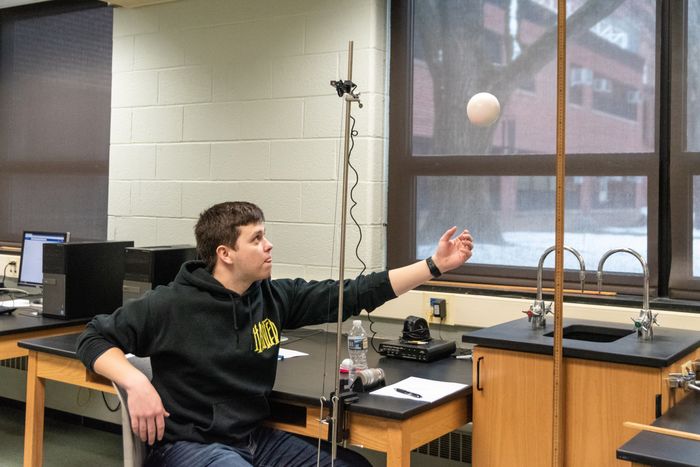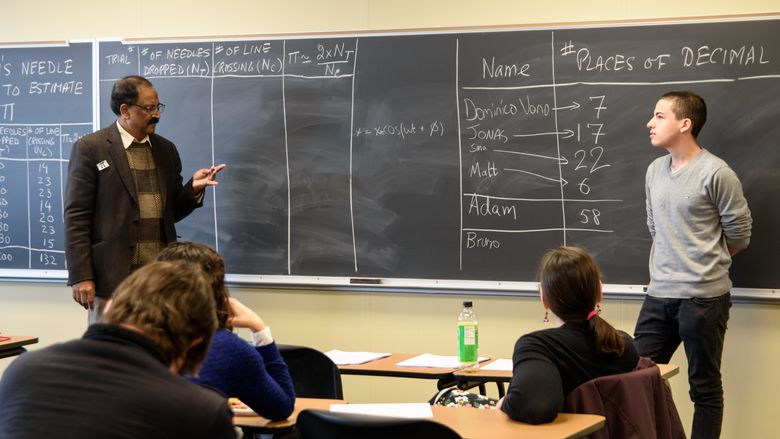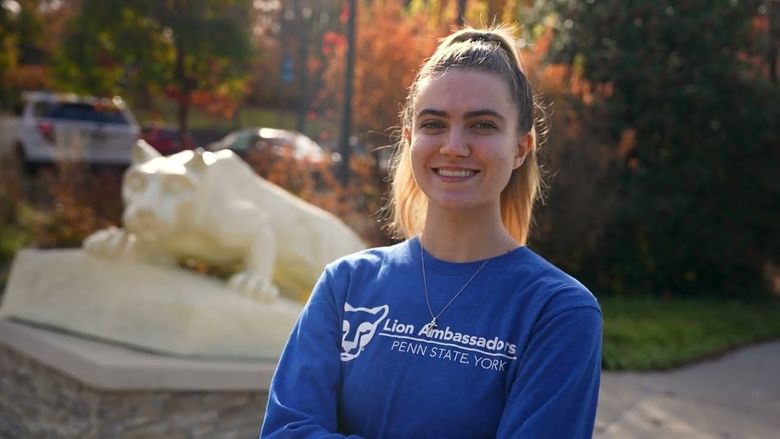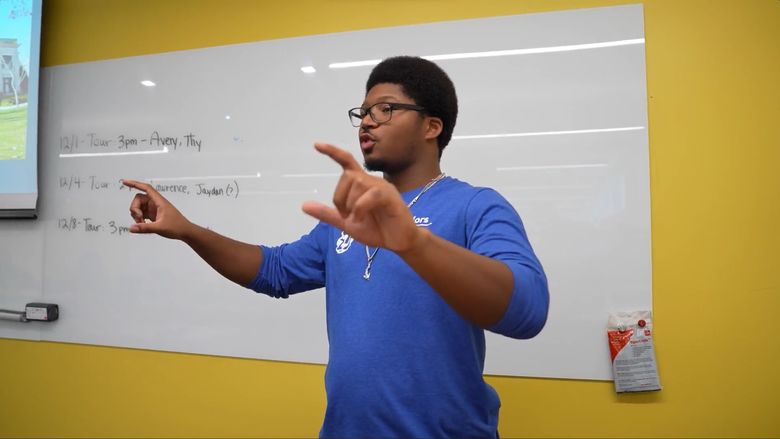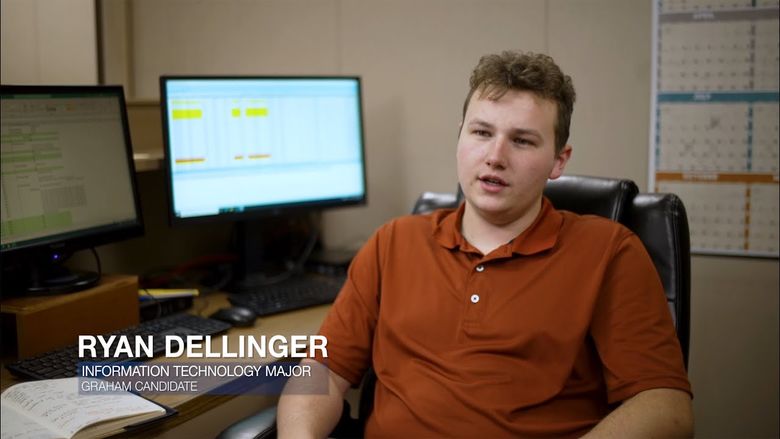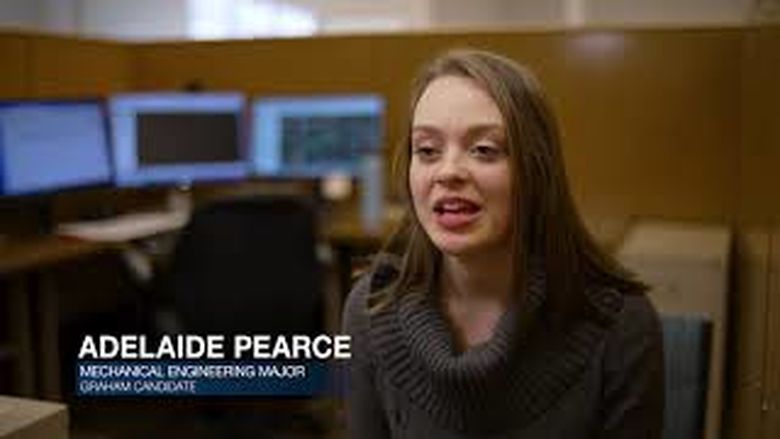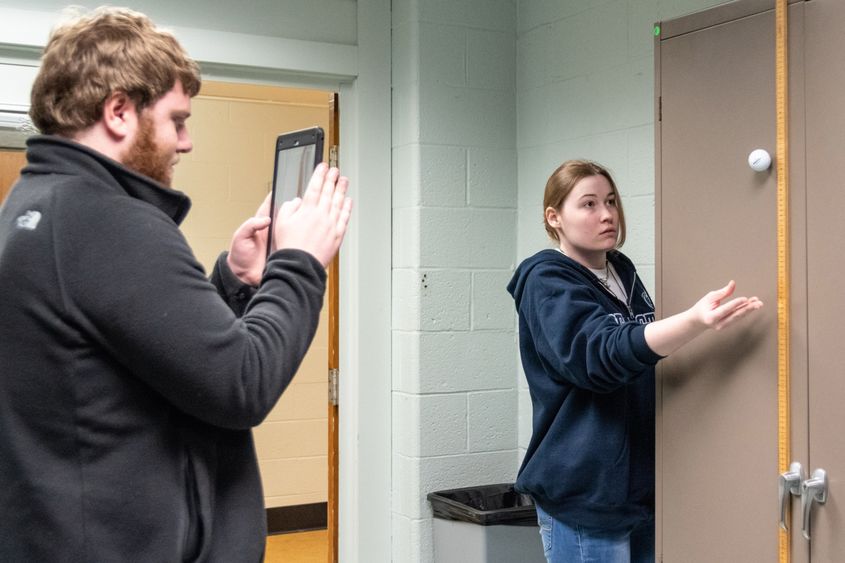
Chelsea Kornbau, right, and Zachary Isey, left, Penn State York students in Physics 211, learned video-capture techniques as they collected video for analysis using their iPad. The students started the project by analyzing the simple motion of a golf ball tossed in the air. This project was funded by a Schreyer Institute Teaching Support Grant.
YORK, Pa. — Kip Trout, lecturer in physics at Penn State York, investigated whether improved student learning occurs when Video Analysis Physics Labs (VAPLs) are used to help students make a connection between the physics learned in the classroom and the real world. Throughout the spring semester, undergraduates involved in the research had the opportunity to engage in lab experiments, which provided them with hands-on experience using iPad cameras and video analysis software.
According to Trout, science students doing traditional laboratory experiments often feel as if the apparatus and experiment have been specifically chosen for good results. They suspect, in the everyday world that they experience, that the scientific predictions will not match nearly as well. Trout explained they misconceive a disconnect between what happens in a lab setting and what happens in the real world; however, many educators have observed that student motivation and learning are improved when students make a connection between the classroom and the real world.
Thinking outside the box
In this particular study, students in Physics 211 chose the video projects that they analyzed, based upon their interests.
"Since many of our physics students at Penn State York are biology majors, they were encouraged to think outside the box and consider investigating the motion of a biological system," said Trout.
Taking up this challenge, one group of biology students measured the force dynamics of a jumping field cricket. By measuring the size and mass of the cricket, and analyzing the cricket's horizontal velocity near the peak of its jump, they were able to measure the air resistance force on the cricket. They discovered that the air resistance on the cricket was larger than expected.
Another group, comprised of engineering students, investigated the acceleration of a falling drop of honey, and found that it is only two-thirds that of free-falling objects. This is due to honey's viscosity and cohesion forces.
Other students chose projects of interest to them. For example, one group with members who enjoy popcorn as a snack chose to study the acceleration and force acting on a popping kernel of corn. They patiently popped one kernel of corn at a time until they were able to capture one that flew close to vertically.
"It was apparent from the beginning that allowing students to select their video project was helping to bring the real world into the physics lab," commented Trout.
Chelsey Kornbau, a sophomore at Penn State York, said that using technology helped her better understand what was being taught. She also like being able to select the type of experiment with which she could be involved.
“I thought it was fun and very helpful,” she said. “Doing those experiments helped me better understand the material being taught in the class.” Kornbau also noted that using the technology provided her group with more accurate information.
Kornbau’s group tracked the movements of a variety of objects that were tossed in the air, and then filmed them falling in slow motion, using an iPad. The information gathered through the videos was then used to make graphs, with the computer graphic program, Logger Pro. The graphs presented information that was easy to understand.
Bringing labs to life and testing understanding
The students shared eight Apple iPads, made available by a Schreyer Institute Teaching Support Grant through the Schreyer Institute for Teaching Excellence, to capture the videos for their projects. Modern iPads have sophisticated video capabilities and can capture 120 frames per second in slow-motion mode with no special lighting requirements. Combining these with Vernier's Video Physics app, which can be downloaded for $5, and Vernier's Logger Pro software on computers in the physics lab, was all it took to vivify Trout's physics labs.
The average score for the entire population of subjects on the post-test was 87 percent for questions related to graphs and associated motions; Trout had a goal of 90 percent for graphing questions. With a normalized gain of 0.39, it is clear, however, that the pedagogical method employed produced impressive gains in students' understanding of kinematics graphs, said Trout. Typical gains with traditional approaches in instruction result in gains of about 0.23, according to the literature in physics-education research journals.
Trout's testing mechanism checked the students’ understanding of the basic laws of motion and their understanding of graphs of position vs. time, velocity vs. time, and acceleration vs. time.
Additionally, by the end of the study, the subjects were correctly answering almost every question regarding the direction of velocity in problems (g=0.64 and 91 percent), achieving the the ambitious goal of 90 percent. The goal of having students better trust the laws of physics and equations that they learned in class did not reach 90 percent as hoped; however, the overall confidence level of the class improved from 65.6 to 73.4 percent.
"One can speculate that the confidence of the class was held down by the fact that some of the self-chosen VAPL projects were a bit too ambitious for introductory students," said Trout.
All things considered, said Trout, the results suggested that using student selected VAPLs with open-ended design in introductory physics labs will lead to significant gains across the student population in their interpretation of kinematic graphs and associated motions.
This conclusion agrees with work by previous teams of researchers in physics education, said Trout. He is preparing a manuscript summarizing the study.
"I'm grateful to the Schreyer Institute Teaching Support Grant for the lion's share of the financial support for this project, and also to the faculty, administration and information technology staff at Penn State York," said Trout. He added that Larkin Hood, instructional consultant and assistant research professor at The Schreyer Institute for Teaching Excellence, made many helpful suggestions; and James Oplinger, a systems administrator at Penn State York, provided valuable technical support.
